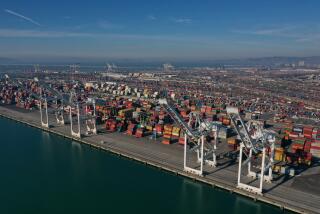Grain Traders Fear Traffic Jam on River : Transportation: If the Mississippi’s aging lock system for barges fails, the industry, which makes pennies on the bushel, could be in serious trouble.
- Share via
WASHINGTON — Grain traders who have long relied on the Mississippi River to move produce from the farm to their international customers are worried about the chances of a major failure in the waterway’s aging locks.
Twenty-eight of the 33 locks on the upper Mississippi are more than 45 years old, as are seven of the eight locks on the Illinois River, according to the grain industry.
According to Army Corps of Engineers estimates, half of those locks will reach their capacities by 2000. That will, in effect, result in a standstill of barge traffic.
U.S. grain merchants could face longer shipping delays and higher transportation costs for an industry that makes pennies or less on a bushel of wheat, corn or soybeans.
“An aging lock, combined with high usage, gives rise to increased down time and increased operating delays. These factors also increase the chance for a major failure of the structure,” said J. Stephen Lucas of Louis Dreyfus Corp., one of the world’s largest grain traders.
“Any of these events . . . mean increased transportation costs for U.S. grain shippers and handlers, which is ultimately translated into a lowering of gross farm income,” said Lucas, director of logistics and operations for Louis Dreyfus, in recent testimony before a Senate subcommittee.
According to Lucas, 65% of all U.S. grain exports last year--or 63 million tons--moved on the nation’s inland waterways. Barge transportation is by far the cheapest way to move grain, and provides competition to the railroads, officials said.
The Army Corps of Engineers, which operates the commercial locks and dams on the inland waterways, agrees that the situation on the Mississippi River is serious.
Although the locks have been renovated over the years, only one has been replaced. Another was expanded.
The system is still largely operating under the technology of the 1930s. And its lock sizes are designed to handle the smaller tows of decades ago as it approaches 2000 and ever-heavier traffic.
“There is recognition within the corps that this is becoming an increasingly urgent problem,” said David Grier, transportation geographer for the Army Corps of Engineers’ Institute for Water Resources at Fort Belvoir, Va.
He said statistics show increasing delays to barge traffic, particularly on the Upper Mississippi below the southern tip of Iowa.
More to Read
Sign up for Essential California
The most important California stories and recommendations in your inbox every morning.
You may occasionally receive promotional content from the Los Angeles Times.











